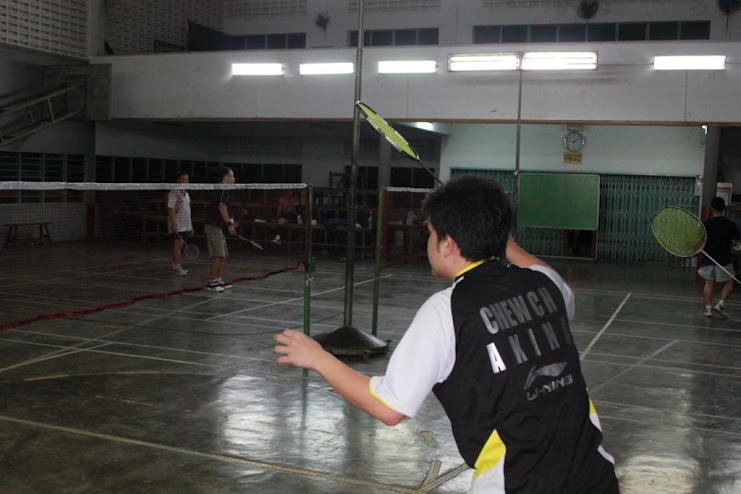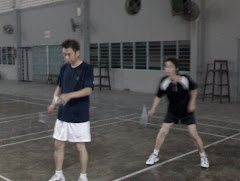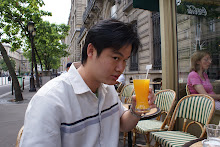LEARNING AND TEACHING THE ART OF DECEPTION
An interesting and attractive feature of badminton is the numerous opportunities that occur in play for deceiving the opponent. For some players there is a certain satisfaction to be experienced in keeping the opponent guessing and then tempting him/her to go the wrong way from the shuttle. The best exponent of the art of deception that I ever watched and had the good fortune to play against was Finn Kobbero, the great Danish player of the 1960s', whose skill was so great that even his fellow players would crowd around the court to see what new tricks he could pull out of his bag. Nowadays, with few exceptions, it is a neglected art as the majority of players rely on power, speed and fitness to try to defeat their opponents. No one could deny that the modern game is dynamic and exciting but one might also assert that it often lacks the unexpected, the element of surprise.
There are several possible reasons for the neglect of deception. First, the fitness revolution of recent years has led to a greater emphasis on speed and power and made deception seem unnecessary. Second, these days more young players are coached and thus spend more time learning and practising strokes in mindless routines. Without an opponent there can be no deception which is one possible reason why the self taught players of earlier years possessed more deception; as being self taught they learned to play by playing and their focus was more on their opponents than on stroke production. A study of many players today might confirm that, in general, many coaches do not appear to teach deception, perhaps because not using it in their own play they find it difficult to teach. Whatever the reasons deception is an art that players would benefit from if they learned to use it. Players certainly need it to enhance their skill and to improve their tactical play. It would certainly increase their chances of creating more situations in which they could make a winning hit.
A discussion of the art should make clear what is involved and thus make it easier for coaches to teach it and players to acquire it. For deception to occur someone must be deceived, in the game this takes the form of a pretence by one player who tries to communicate to his/her opponent via body language, his/her intention to perform a specific stroke-move when in actual fact he/she intends to perform a different stroke-move. For example A pretends to smash and then hits an attacking clear. A may intend to deceive B in all sorts of ways but there is no deception unless B actually is deceived and A will not know this until B makes the response which A had planned for.
When A pretends to smash, for deception to occur, B must identify A's behaviour as, A looks as if to smash behaviour. B must interpret A's intention from his/her movements. If B does this then B should make the appropriate response to a probable smash and take up a defensive stance. A can now hit the shuttle over B's head and know that he/she has succeeded in deceiving B.
It is essential that coaches and players appreciate what is involved in the deceptive act. A will communicate his/her intention to 'smash' non-verbally, through his/her movements.
If the deception is to succeed then A must know with some degree of certainty that B will recognise that A's movements indicate that a 'smash' is about to be played, It is as if A presents a picture of him/herself which B perceives and interprets as being of a certain sort. B's response will reflect B's actual interpretation of that picture. Should the picture be unclear, vague or too complex: then B may not be able to interpret A's movements as being of a certain sort and consequently not respond as A desires. Even if an interpretation is possible there may not. be sufficient time to make the desired response, B could read the intended stroke-move but have no time to make a response. In both instances the deception would fail.
It is necessary, therefore, that any player using deception does present a clear picture to the opponent, one which the opponent will recognise, and allows sufficient time for the opponent to interpret the picture and to make the desired response, If A is successful in this task then A can manipulate B's movements to his/her advantage.
I am reminded of one England player of some years ago who possessed quite subtle deception at the net., He used several flourishes of the racket to bring the opponent into the net before flicking the shuttle over the opponent's head to the rearcourt. Unfortunately on this particular occasion his opponent could make no sense of these flourishes and didn't respond but remained still watching this magical performance from the midcourt. When the flick came he was already in position to gratefully smash the shuttle down. The England player didn't seem to understand why his deception failed; that the outcome of deception must be that the opponent actually does make the wrong response in the situation and allows the hitter to outwit him/her.
Using deception
Deception has a tactical basis and consequently should be used only to create situations which will increase a player's chances of winning the rally. Such situations are as follows:
1, When the shuttle is high in the rearcourt or midcourt one should prepare as if to smash so forcing the opponent to adopt a defensive stance which makes it less easy for the opponent to move quickly to the rearcourt or forecourt. One can then play a check-smash (drop shot) or an attacking clear and so perhaps play a winning move or obtain a weak reply.
2. When the shuttle is low in the midcourt and the opponent is on the attack one can look as if to return the shuttle to the opponent's left or, right side, to the net or to the rearcourt; causing the opponent to transfer his/her weight in the opposite direction to the actual hit - to go the wrong way. Consequently the opponent is caused to be too late in getting into position to play his/her stroke-move or late enough to make a weak reply.
3. At the net. one can look as if to play a straight net reply, the most attacking move in the situation for, if successful, it would force a lift, and thus cause the opponent to move forwards so creating a chance to flick; the shuttle over the opponent's head.
There are two points to consider when using deception in these situations. First, deception can be most effective if one looks as if to make the strongest attacking move in the situation for that is the biggest threat to the opponent and one move he/she must cover. Second, always have the racket prepared to hit the shuttle as one approaches it. In this way one can pause during the stroke cycle with the racket held in the preparation phase and so create the illusion of holding the shot thus tempting the opponent to anticipate a probable move.
It is in this context that deception links up with anticipation which is when a player moves prior to the hit in the belief that the shuttle is to be hit to a certain place in the court. The deceiver is successful if he/she manages to persuade or encourage the opponent to judge wrongly.
There is also of course a way of preventing the opponent anticipating the probable move - a way which can be adopted by players who do not use deception. Most good players try to anticipate the opponent's likely move which is why the deceptive player can be so successful. But it is also possible to prevent early anticipation, if any, by using good technique in stroke production. Those players who do anticipate well usually do so because they read the signs which the opponent shows as he/she gets ready to hit the shuttle. You most probably do this yourself with players whose game you are very familiar with. Small movement habits and mannerisms provide clues to the intelligent player as to what the opponent intends to do. But if there no clues or very few on which to make a calculated guess as to what the opponent will do then it becomes difficult, if not impossible, to anticipate what the opponent will do. One has to wait and see.
Rather than looking as if to play a particular move, e.g. a smash, a player can prepare to hit the shuttle and not look as if to do any particular type of move thus presenting a neutral picture to the opponent. He/she, therefore, presents the opponent with no information on which to make a positive interpretation. The opponent has to wait until the shuttle is hit before travelling into position to make a reply. To obtain this effect an identical preparation for similar types of strokes is required. Rudi Hartono was an excellent example of this type of player. In most situations he would prepare early and then simply wait until the last moment until he struck the shuttle. Opponents found it difficult to 'read' his probable move and had to wait until the hit before they dared move.
Players who develop unnecessary and superfluous stroke habits will find that they provide their opponents with sufficient information to enable them to interpret the 'picture' correctly and anticipate the intended move very early. To avoid this happening all players should, at the least, try to develop good technique which they will do if they can simplify their stroke production. Players who are able to do this will progress more easily towards acquiring the art of deception.
Learning to use Deception.
Any player with good technique will already possess simple efficient strokes with an identical preparation for similar strokes; and consequently such players will also look as they intend to make a particular move in a situation.
These players will already possess the basic ingredients for deception. But the essence of deception is that the opponent is deceived. To learn deception a player must develop a particular attitude towards the game. He/she must appreciate the value of deception as a tactical aid and develop his/her skilful use of the racket. There has to be some enjoyment felt in outwitting the opponent in this way, to trick him/her, and to entice him/her to make a futile movement. Above all the player must relate what he/she does to the opponent. He/she is the focus of attention and he/she is the person who must be thrown off-balance, sent the wrong way, fooled and deceived sufficiently that the chances of winning the rally are increased. There should be no danger of indulging in too much deception as long as players remember that its purpose is purely tactical.
To learn deception a player must practise deception. This is a two part task. One part is to learn and practise the strokes and become skilful in the use of the racket and the body; so that one can look as if to do one thing and then do something quite different,e.g, begin a smash and change it to a drop shot; look as if to hit the shuttle to the rearcourt from the net and change it to a net reply and vice-versa; sway one way to draw the opponent off balance and then hit the shuttle the other way. These are typical of the actions one must practice before tackling the second part of the task which is to apply them in the game and take a delight in using them to catch the opponent out.
Teaching Deception.
The task of the coach should be apparent from the foregoing account. Coaches must teach good technique in racket and body skill; ensure that players understand and appreciate the use of strokes as tactical moves and then encourage players to use their skill to deceive opponents in order to gain a tactical advantage. The player who possesses the technical and tactical skill, the fitness and the character to compete with the best requires that little bit of extra to rise above the others. The art of deception may help players to do just that
Players Profile
Name: Chew Chin How
Age: 31
Hand: Right
Height: Not so tall
Power: Packs a punch when on form
Stamina: Avarage, improving if he goes to Mengkuang for more fitness training
Experience: Played for school and District. Played in Kulim open tournaments and CRC close tournament.
Achivement: MSSK Silver madelist (12 years ago)
Win/lose ratio 2011 : 20/12
Ranking Akina: Seeded 2 or 3rd doubles at all times.
Weapon of Choice: Yonex Nanospeed 9900 (at the moment)
Shoes: Asic gel
Age: 31
Hand: Right
Height: Not so tall
Power: Packs a punch when on form
Stamina: Avarage, improving if he goes to Mengkuang for more fitness training
Experience: Played for school and District. Played in Kulim open tournaments and CRC close tournament.
Achivement: MSSK Silver madelist (12 years ago)
Win/lose ratio 2011 : 20/12
Ranking Akina: Seeded 2 or 3rd doubles at all times.
Weapon of Choice: Yonex Nanospeed 9900 (at the moment)
Shoes: Asic gel





2011 Akina Home & Away Jersey's


Subscribe to:
Post Comments (Atom)
2011 Team Captain

Ah Leong in full glory



Master Blogger and Double Motion Specialist

Deepavali is over back to playing badminton.
Its been a week filled with food and a lot of eating. Deepavali goodies has just been too good this year. So I thinks ita about time to burn all that food by playing our favourite game. I hope the turn out would be good this Thursday. Last week only a handfull of us turned out due to many unforseen reasons so hopefully this week will be a full house.
Anyway, time to pack up my stuff for tonight and hopefully we will see a big turn out tonight. Catch you guys all later
Anyway, time to pack up my stuff for tonight and hopefully we will see a big turn out tonight. Catch you guys all later
Ah Cheng and Yap No.2

Ah How and His Wife Having some fun

Give me 2 more shots
Players Profile for the Month of October.
Name: Ah Tiong
Nick Name: Ah Teong
Age: 30+ ( i think)
Playing Style : Defensive. Likes to lambomg the ball and wait
for smashes.
Playing Since : 1993
Which hand prefered: Right handed player.
Racket of Choice: How the hell would the master blogger know
Height: 5' 9"
Weight: 70kg +/
Smashing Power: 5/10 (sometimes 6/10)
Defence: 6/10
Overall : 5/10
Nick Name: Ah Teong
Age: 30+ ( i think)
Playing Style : Defensive. Likes to lambomg the ball and wait
for smashes.
Playing Since : 1993
Which hand prefered: Right handed player.
Racket of Choice: How the hell would the master blogger know
Height: 5' 9"
Weight: 70kg +/
Smashing Power: 5/10 (sometimes 6/10)
Defence: 6/10
Overall : 5/10
Ah Tiong

Feels like a sauna in here
Ah Tiong Serving
Ah Tiong

Silent Killer





















No comments:
Post a Comment